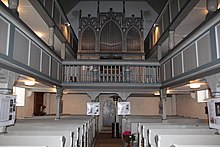St. John the Baptist and St. Blaise
The Evangelical Lutheran Church of St. John the Baptist and St. Blasius in Wiedersbach , a district of the municipality of Auengrund in the Hildburghausen district ( Thuringia ), was built in 1487. The namesake are St. John the Baptist and St. Blasius .
history
The church, which stands on a south-facing slope, was originally a fortified church with a two-meter high wall and a deep moat. The oldest part, the choir , was originally built as a chapel by the Order of St. John Schleusingens in 1487 . It was the first church in the Henneberger Land in which Protestant services were held as early as 1523. Today's late Gothic appearance was created as part of an extension with the nave and the church tower in 1601. In 1617 it was decorated with frescoes . In 1721 the galleries were built in and the frescoes were probably painted over. In 1893 the walls of the nave were raised by about one meter with stones from the neighboring cemetery wall and the roof structure was renewed.
The church tower, standing on the west side, has a slipped pointed helmet, consisting of two pyramids placed on top of one another , and is a total of 42 meters high. He has a hen as a weather vane . Cornices structure the four-story tower with its exposed sandstone walls.
The choir is spanned by a ribbed vault. The southern outer wall of the nave has a small Romanesque arched window as a special feature . The church interior offers space for 300 people with its two-storey galleries .
The pastor's post in Wiedersbach has been vacant since 1987. Waldau initially administered the parish , later St. Kilian .
Furnishing
In 1961, during an interior renovation in the chancel and on the triumphal arch, wall and ceiling frescoes from the late Renaissance were discovered. The ceiling frescoes in the chancel show the four evangelists , the north wall the Holy Communion, the east wall Moses with the command panels and the staff, and the south wall Martin Luther and Philipp Melanchthon .
The stained glass window in the east wall with the head of Christ dates from 1895. It is the work of the Ferdinand Müller glass painting company .
The font dates from 1618. The pulpit next to the triumphal arch is supported by a symbolic palm trunk.
Four bells, two old bronze bells and two hard-cast iron bells from 1952 hang in the church tower. Johannes Rossanger cast the oldest and smallest bell with the tone D in 1483. The middle bell from 1507 with the tone B is the work of Peter Gereis. The large and small bells were cast in Apolda in 1952 by the Schilling company . They replaced two bells that were melted down during World War II.
The organ , inaugurated in 1883, was built by the organ builder Theodor Kühn from Schmiedefeld . It replaced an organ from 1696 that was destroyed by lightning on June 4, 1882. Today's organ is no longer playable (as of 2014).
literature
- Joachim Neubert, Günter Stammberger, Bernhard Grossmann, Martin Hoffmann: The churches in the district Hildburghausen ... none other than the house of God - the gate of heaven ... . Verlag Frankenschwelle, Hildburghausen 2006, ISBN 3-86180-174-4 , p. 328.
Web links
Individual evidence
- ↑ Karin Schlütter: Pastor Triemer discovered Romanesque church windows . www.insuedthueringen.de, September 14, 2012
- ↑ Pastor's Book of the Church Province of Saxony, Volume 10, Series Pastorum. Evangelische Verlagsanstalt Leipzig, 2009. p. 718
Coordinates: 50 ° 28 ′ 32 " N , 10 ° 47 ′ 58" E



